Bicycling on the Friendship Highway
From Lhasa to Kathmandu, crossing passes at 5,000 meters
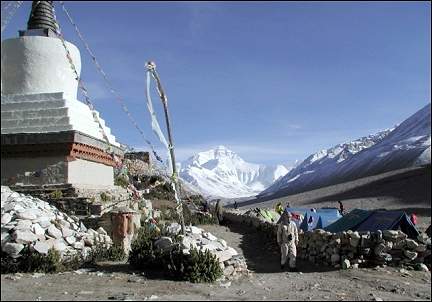
|
The Friendship Highway is still asphalted south of Lhasa, but that changes quickly when it meanders over 5,000 meters high passes in the Himalayas. In the course of the 1,100 kilometers to Kathmandu in Nepal, the Highway frequently isn't even recognizable as a road. At great altitudes, between the mountains, you can find shellfish on a former ocean floor. Bicycling in Tibet is extreme, in many ways.
Travelogue & photos: Pieter Parmentier
The Gyatso La (aka Jia Tsuo La or Lhakpa La or Pass of the Winds) is a rather high pass, actually it is one of the highest in the world. My method to conquer this Tibetan, 5,220 meters high bump is very simple: get on my bike and keep pedalling. Non-stop climbing for thirty kilometers at this altitude is definitely different from what I do in Europe, but the principle works all the same.
When I arrive at the top, I look around with a feeling of complete satisfaction: there are easier ways to get a kick, but this is extremely satisfying.
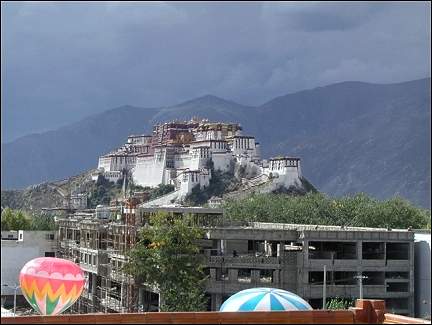
|
Bicycling in Tibet is extreme in more than one way. It is extremely beautiful, the roads are often extremely bad; you don't have to do it for the food and the sanitary facilities aren't a draw either. What remains is an unforgettable experience and memories that will never fade.
Let me begin at the beginning: why does a group of friends choose to bicycle in a country like Tibet, even though there are so many beautiful mountain passes in Europe? Why look for these hardships, even though you can get tired climbing Mont Ventoux as well?
The answer is surprisingly simple: we wanted to do something different. If you have climbed most well-known passes in Europe, they tend to become somewhat predictable.
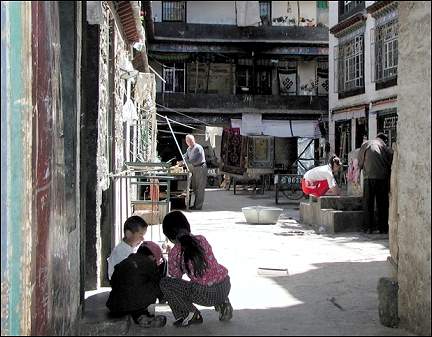
|
So we decided to do this and then cautiously tested how our families and friends felt about it. After two years of preparation we got on an airplane to Lhasa, the capital of the "Roof of the World."
Lhasa
The highest located capital in the world
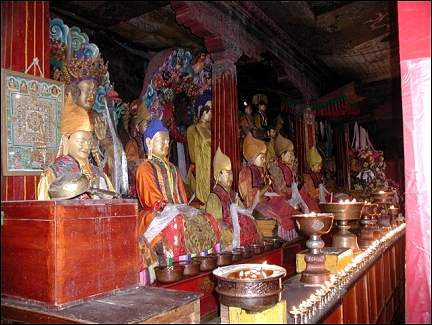
|
After arriving at 3,600 meters, the first stairs you have to climb are a challenge. So it's not an unnecessary luxury to acclimatize for four days in this fascinating city. And even less a waste of time.
We wander through the streets and monasteries of Lhasa and look around in amazement. It's an extraordinary city, this highest located city in the world. Especially when you have just visited Kathmandu. These two cities are as different as can be.
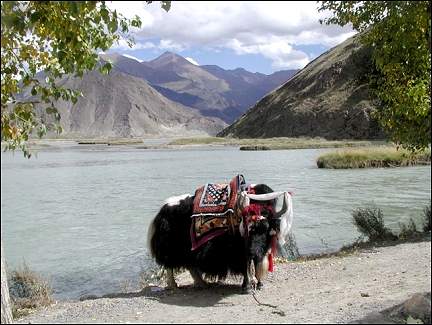
|
The river in Kathmandu looks like an open sewer and that is exactly what it is. The ones in Lhasa, Tsangpo (Brahmaputra upstream) and the Kyi Chu, meander majestically through the wild, wide landscape.
The air is clear and tingling, while in Kathmandu it is warm and stuffy. Both cities can cause oxygen depletion, but in Kathmandu that is because of car exhaust, while in Lhasa it's because of the altitude. In Kathmandu you have to look a long time before you find a modern building in the narrow, hilly streets, while in Lhasa the streets outside Barkor, the market district, have six lanes and are level and there are many modern buildings, which are rarely nice-looking. Traffic seems reasonably well-organized, but nobody pays attention to anybody else. In Kathmandu, on the other hand, traffic is a complete chaos.
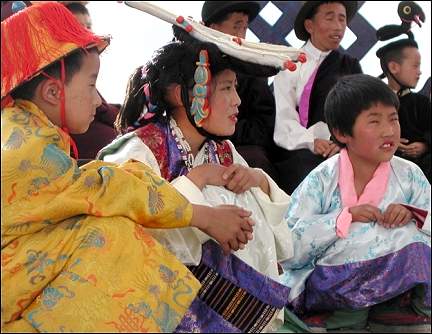
|
Street peddlers are persistent in both cities, but in Lhasa they are women and in Kathmandu men. (Bicyle) cabs are driven by men, but the streets in Lhasa are swept by women; in Kathmandu they aren't swept at all.
We visit the Project for the Blind, the only school for blind children in Tibet, to donate our sponsor money. We are just here to bring money, but we are treated to a heartwarming theatre performance. To be quite honest, I can't follow it completely, but the overwhelming enthusiasm, the complete lack of shyness and the stunning costumes make it unforgettable.
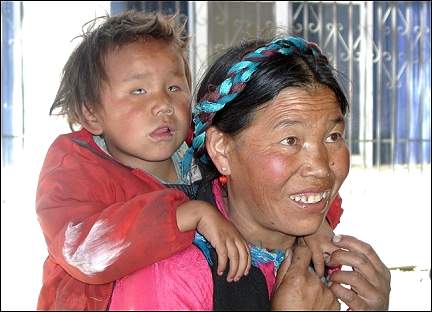
|
Most of these children have never received any praise from anyone and they have no confidence at all; in Tibet blindness is considered divine punishment. One of the little actors is a boy who was left on the Lhasa market last year, and exchanged for a girl who can see and therefore be useful.
Often we can't even see the road
Overcoming adversity is good for your karma
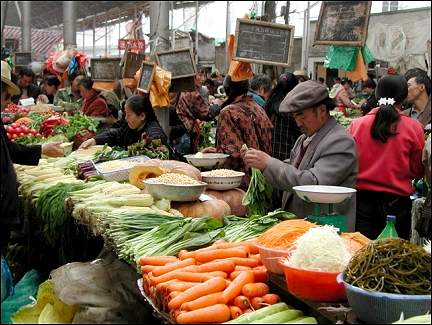
|
We tinker a bit with our bicycles and then it's time to leave. Twelve bicyclists and a truck are on the way to bridge and survive the 1,100 kilometers between Lhasa and Kathmandu in two weeks.
The first leg is a piece of cake, except for the guesthouse where we spend the night. We ride on asphalt and suspect that we won't see this kind of pavement very often from now on. We are right. The guesthouse doesn't have running water nor a toilet. We think that this is probably normal in Tibet and that turns out to be right, even though there usually is something that serves as a toilet.
We also discover that it's less quiet at night than in the daytime in Tibet; it's not an exaggeration to say that nights are noisy. But the sources of noise vary. Usually it's karaoke, but there are also barking contests between dogs, and fights.
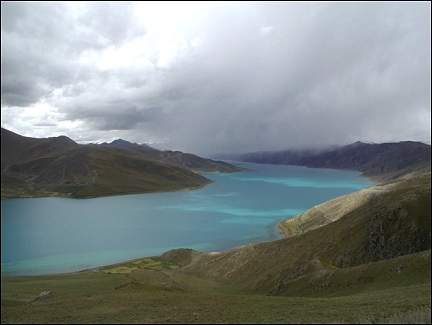
|
The next morning it begins for real. We leave the asphalted road and start to climb: from 3,600 meters to the Khampa La pass at 4,800 meters. I frequently get off my bike to take pictures for my daily report which is sent to family and friends through the internet.
When we reach the Khampa La pass, we enjoy the view of the unlikely azure, giant Lake Yamdrok which lies far below us.
The weather stays fine, as it should in September. Apart from a few hail showers, the weather is great for biking, with temperatures up to 20 degrees centigrade. We are less happy with the roads. They are hardly ever asphalted and frequently they're not even recognizable as roads, even though this is the Friendship Highway, the trough-road to Kathmandu. This way, descending is not a reward for climbing, but torture for our behinds and arms.
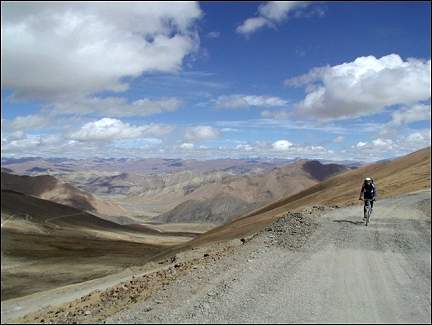
|
It's a miracle that our bikes stay in reasonable condition and I am not surprised that often one of us has to sit in the truck because of physical problems. One of our friends has reached his physical limits after only a few days, when the dreaded altitude sickness makes bicycling impossible for him.
All of are affected by the altitude to some degree. Headaches are frequent and so are other symptoms that usually point to alcoholic overindulgence, but which really have a different cause here.
Is this still fun? Fun is not the right word. The benefits (the experience, the group solidarity, the wonderful surroundings, the feeling that you get after climbing such a mountain, etc.) outweigh the drawbacks by far. Overcoming is also good for your karma, as they say in Tibet. I'm not an expert in this field, but apparently it means that you have a better starting point in your next life. So it looks good for us, after today.
Amazingly friendly and happy
Don't be suprised if rocks are thrown
The population of Tibet is amazingly friendly and happy. It is surprising because the natural living conditions are difficult and also because it is an occupied country. Because of this, it's hard to get in contact with adults.
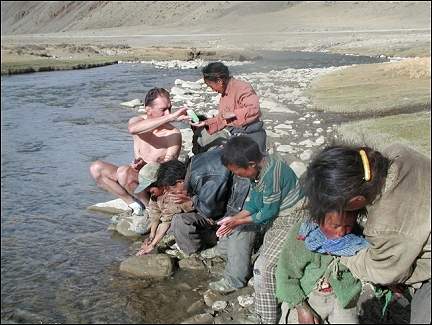
|
With children it's very simple. The appear everywhere when we ride through the landscape and they make it clear that they are there and what they want. The friendly greeting "Tashi dele" is without exception followed by outstretched hands with the palms up...
If you have nothing in your pockets they like, don't be surprised if you get pelted with rocks. But we also have very nice encounters with children. One thing I won't forget any time soon is bathing in the river with a bunch of them.
An ocean floor at 5,000 meters
Children sell fossilized shellfish
Tibet is dusty. That is partly because of the condition of the roads, or rather the material with which they are paved. Tibet was formed 50 million years ago, when the Indian subcontinent collided with the Asian continent. The two tectonic plates were pushed up where they collided and formed the Himalayas, and the Kunlun and Shan mountains.
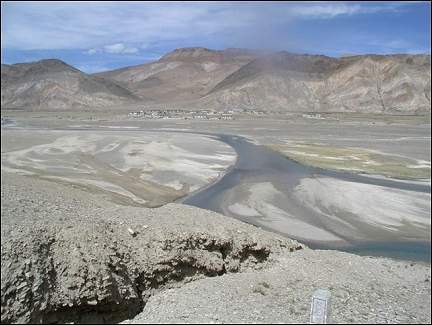
|
Between these mountain chains (which still rise 10 centimeters annually) a piece of ocean floor is hemmed in which was pushed up with the rest. A large part of the region we cross, is former ocean floor (clay, boulder clay and loess) which is very dusty when it's dry.
The composition of the soil has other disadvantages as well. Because the mountains are also mostly clay, whole mountain slopes slide when there are heavy rains. Frequently villages and roads are swept away. No wonder Tibetans are always busy with their roads and that they are bad despite all their work.
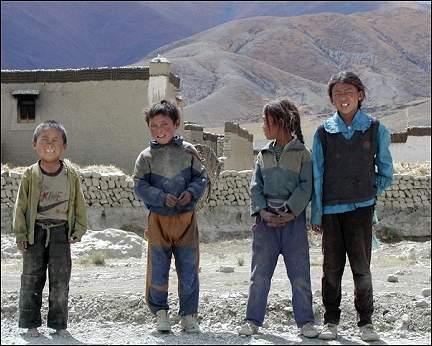
|
The history of this region also explains why you meet children here who are offering fossils for sale. These fossilized shellfish are found in large quantities in some areas, but it still is a strange experience to meet children at an altitude of 5,000 meters selling shells.
The guesthouses are full of surprises
No running water, no toilets, but there are "ladies"
From a dreary brothel to the sunbathed plateaus of Lhatse, an easy ride today. I will have to explain this.
The guesthouses are full of surprises. The lack of running water and toilets is one of them, but there is also entertainment.
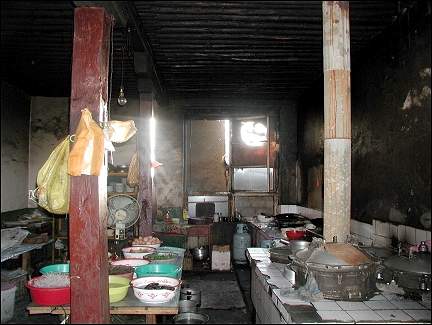
|
Yesterday we decided that it was best to camp out for the night. When we arrived at a pleasant spot, with running water (the river), a clean "toilet" (the open country), fresh air and guaranteed no karaoke, the driver and guide rebelled. Two kilometers farther there should be a wonderful guesthouse!
We already had our doubts about Tibetan concepts of wonderful guesthouses and distances, but we were willing to take a look. So back on our bikes. After 12 kilometers we find, in the middle of nowhere, in an extremely cold location, a kind of guesthouse. A dining hall and some bedrooms with mattresses on tamped down earthen floors, and a bar. The only thing that was remarkable, was the great number of young female staff, but we didn't mind; we were tired and hungry and we hadn't expected to be able to shower anyway.
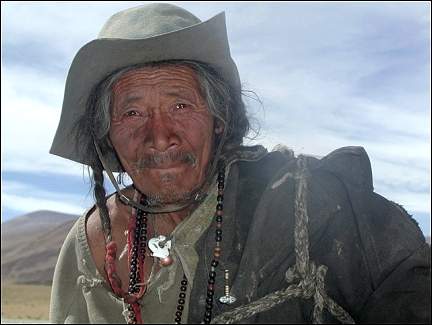
|
The driver and guide disappeared almost immediately and we didn't see them again until this morning, when they showed up in remarkably good moods. After this, we found out that almost every guesthouse has some ladies who will serve more than food and drinks if necessary.
We are also in a great mood, but for different reasons: we eat better, sleep better and the roads are a little better (worse is impossible). That is a good thing, because tomorrow we have to conquer another pass at 5,000 meters.
Highlight Mount Everest
The monks make us sit around the hearth to defrost
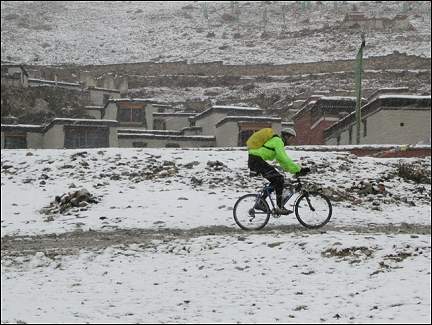
|
We are approaching Mount Everest, also the litteral high point of our trip. The weather changes and we ride in the drizzling rain all day long. At 5,000 meters is changes into snow. When we arrive at the famous Rongbuk monastery, we are completely numb with cold and are greatful that the monks make us sit around the hearth to defrost.
It takes a while before the yak-dung burning heater and the yak- butter have warmed us back to almost 37 degrees centigrade.
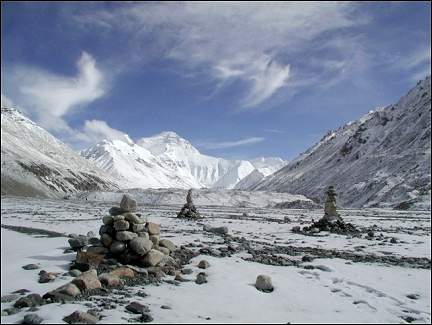
|
Outside again, we see the weather improve slowly. Our fear that we rode this long distance for nothing turns out to be unfounded. The sun breaks through the clouds and we have a breathtaking view of the almost 9,000 meters high Chomolungma (the Tibetan name for Mount Everest).
The next day we descend to try something new. Our map shows a shortcut that would save us a day. This is important because we are behind schedule. The only question is if the rivers we need to cross have fords.
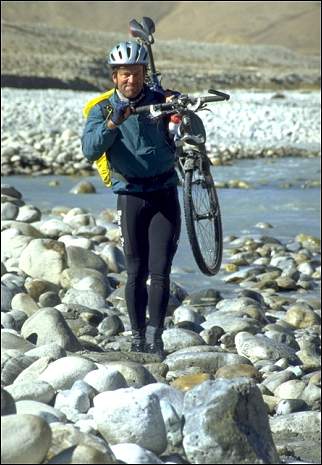
|
We are lucky. The water level is low enough, but this leg is also the most beautiful so far. Everyone has images of Afghanistan in their heads and they are barren and dry. Tibet looks a lot like Afghanistan, but not as dry and with more color. And of course a biking tour is a better way to see a country than from a bomber.
We stumble through rivers, climb again to over 5,000 meters, while the wind increases to a hurricane. But it's unbelievably wonderful and for once we have tail wind. At the end of this leg a real shower awaits us!
Nepal
Descending into the warm blanket of a tropical forest
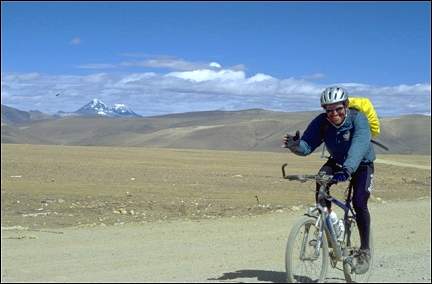
|
We are approaching the Nepal border and are looking forward to conquering the last 5,000 meters pass, Lalung La. Or, actually, the descent that follows, which is one of the longest in the world with its 160 kilometers.
But it turns out that the kilometers we rode so far were just a training for this descent. We have an extremely strong headwind and there is so much dust on the road that we come to a grinding halt.
Still it is a magnificent experience (not to mention good for our karmas). We descend from 5,000 to 500 meters in two days: the changes are huge. From the silence of a scent-free and colorless desert to the warm blanket of a tropical forest. And from the friendly, but tough and aloof Tibetans to the sociable and agreeable Nepalese, in an environment that encourages you to be laid back.
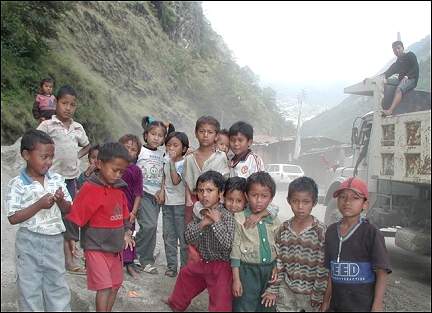
|
But we still have a distance to cover. Even though the time pressure is off, and we even can afford to sleep in, we still have to bicycle to Kathmandu and then to Dulikhel.
It's not that we are worried about the Nepalese pass: it's only at an altitude of 1,600 meters. On the contrary: it's a nice dessert after our Tibet expedition. The large amounts of oxygen in the air allow us to ride up the mountain whistling. The guesthouse that awaits us, makes us forget the many hardships.
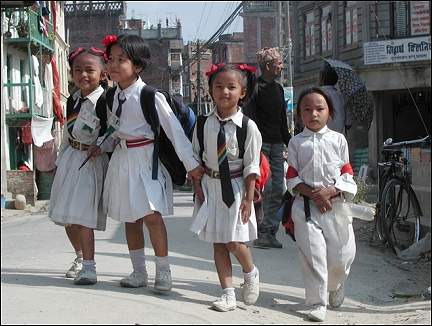
|
While our luggage is taken to the rooms and we are sitting on a balcony with glasses of beer, we can begin to process our experiences. Are we planning more bicycle trips? No, for the moment we only dream of countless hot showers, large glasses of beer and a lot of good food. The modest desires of exhausted bicyclists.